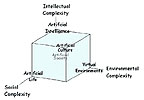|

David Fogel
(consultants) |

Steven Bankes
(consultants) |
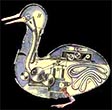
Jean-Philippe Rennard |

Jerry Huxtable |

John Mount |
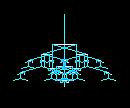
Alife Fusebox |
|
There are, indeed, things that cannot be put into words...
They make themselves manifest...
They are what is mystical...
Ludwig Wittgenstein
(Tractatus Logico-Philosophicus).
|
|
And the signifieds butt heads
with the signifiers,
and we all fall down slack-jawed to marvel at words!
While across the sky sheet the impossible birds,
In a steady, illiterate movement homewards.
Joanna Newsome,"This Side of the Blue"
(2004 Drag City Records).
|
I used to think that the brain was
the most wonderful organ in my body.
Then I realized who was telling me this.
Emo Phillips, Neuropsychology: Clinical and Experimental Foundations
|
| |
Tuesdays |
Thursdays |
|
Calendar Color Code ORANGE:
DAYS SET IN STONE or
DAYS DONE |
Calendar Color Code STRAW:
tentative notes on DAYS AHEAD
based on previous course |
|
Week
0

Challenge 0
The Chaos Game
|
27 August and 29 August combined... |
|
Welcome and Introduction:
Administrative details:
Course requirements are on our syllabus.
"Office Hours" will be here in classroom #6, Tuesdays & Thursdays, before and/or after class.
Please confirm appointments by email in advance.
YOU NEED TO BUY:
12+ burnable CDs and clear-front envelopes. Please, no plastic jewel-cases!
A pen for marking your CDs.
12+ clear and ordinary sheet-protectors for letter-size paper.
1+ USB memory stick. Bring this to every meeting!
Representation, literally "re-presentation":
Naturally evolved: perception, thought, reasoning, natural language.
Culturally evolved: traditions, customs, belief systems.
Technologically evolved: diagrams, mathematics, algebra, calculus.
Our focus: the merged philosophies of evolution and computation.
What are the pros and cons of each of these media of description, understanding and explanation?
Some questions:
- Did we actually discover computation in nature and adapt it to our technologies, and not invent it?
- What happens as we embue our computations with the power that created us: evolution?
- Are discursive arguments presented in serial (sentential) natural language any less "toy models" than computational arguments present in parallel multiagent simulations presented?
- Experience with multiagent complex systems suggests that our predictions are uncertain. Yet they usually provide insightful "clouds" of possibilities to "what if?" questions. Just as drawing an object helps the brain to comprehend and remember the subject, so too does constructing a model force one to pay attention to the details of the system under study. A computational model is also something we can "put on the table" and share with others interested in the problem. We can modify it in this way or that and in the process we gain new perceptions and perspectives. With complex systems there is often no shortcut (no algebra or calculus) for determining the state of that system at a future state (the "Halting problem"). With these systems, the only way to foresee their futures is to run them, step by step, to their completion. We are often forced to confront uncertainty.
- But are social systems comfortable with uncertainty? In hierarchical structures clearly not. Is uncertainty anathema to leadership and governance?
- See, "The skipper always knows...," below. ..
Videos:
U-571 Chapter 12, ending with, "The skipper always knows what to do, whether he does, or not..."
Taking decisive action on false information:
The Gulf of Tonkin Incident and the Vietnam War.
The Weapons of Mass Destruction, "yellow cake" and the Iraq War.
"Were you wrong?" Alan Greenspan fails to see the looming financial crisis.
continued in panel to the right... |
Our programming challenges will progress from simple to complex representations of:
Space (dimensions): cellular (grid-based or raster) or vector (omnidirectional).
Time (when agents take turns or ar polled): cinematic, random, sequential.
Agency (causation): from simple binary agents to those with "senses, thoughts & actions" (STA).
We begin by writing simulations from scratch to gain confidence in our abilities.
Later we progress to modifying and enhancing already developed code.
Remember to explore, experiment, enhance and enjoy your creativity (the 4 "E"s).
A STANDING ASSIGNMENT:
PRACTICE BUILDING APPLICATIONS ON YOUR OWN FROM SCRATCH!
Building a graphics application for Windows PCs with Embarcadero C++ Builder:
(Much of this is reviewed in the left column on our Simulations page.)
- The API: Windows Application Programmers' Interface. See "Help" in the IDE.
- The IDE: Embarcadero Integrated Development Environment. Setting it up.
- The C++ language. See the HANDOUT and also "Help" in the IDE.
- Error messages.
- Color theory & images.
We jump right in and get wet!
PROGRAMMING CHALLENGE 0:
THE CHAOS GAME (or saga of the indecisive wanderers).
An apocryphal narrative: OK, so there's a family wandering the countryside looking for a city in which they can make al living. Let's say there are three cities. They pick one at random and set out towards it. Exactly half way there they camp for the night. Next morning, having forgotten their goal, they pick another one at random and head out towards it. Halfway there again, they camp for the night. And so it goes... As an archaeologist interested in the location of their camps, what pattern, if any, will they form?
FYI: Tabs under which common Visual Components may be found:
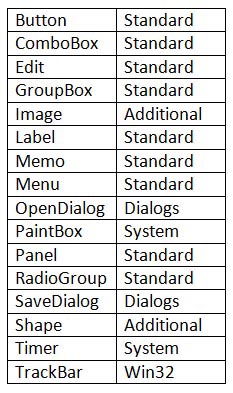 |
Week
1

Challenge 0
The Chaos Game
|
3 September
|
5 September |
Review of FUNCTIONS on the Handout from Day 0...
Programming Challenge 0: The Chaos Game / Saga of the Indecisive Travelers
Continued...
Execution of the program constructs a topographic landscape, but our implementation
obscures much of what is going on.
What are we not seeing?
How could we visualize the complexities and behavior of this system more clearly?
Let's treat it as a landscape? Let's record the "hits" in a world array.
How can we visualize that array? Let's try color and shading.
We implement the colorRamp() function in two directions:
a) Cool to Warm: black, violet, blue... red, magenta, white
b) Warm to Cool: magenta, red... blue, violet, black
c) Casting shadows: faux shadows (a kludge, a cheat, a heuristic)
A look at some other variations on the Chaos Game under "Fractals & Strange Attractors:"
a) varying the multiplier (divisor)
b) adding the third dimension
c) adding sonification to the visualization (can this help to "hear" the pattern?)
d) a "bent" version (flipping the "+" to "-")
What else might we try to enhance, enjoy, experiment and explore this "world?"
Brain-storm some ideas and ways to implement them...
continued in panel to the right...
|
Ensuring that you application will run on any PC operating system:
Project / Options / C++ Linker: set "Dynamic RTL" to false.
Project / Options / Packages: uncheck "Build with Runtime Packages."
Project / Options / Application: uncheck "Runtime Themes."
DUE ON THURSDAY MORNING: Programming Challenge Alpha:
Using the same format as our regular challenges, write a simulation of a simple game of chance, either:
- Roll a pair of dice.
- Pick a card.
- Play a slot machine.
|
Programming Challenge 0: The Chaos Game / Saga of the Indecisive Travelers
Continued...
We consider:
Stephen Wolfram on the Chaos Game.
More Interesting Patterns.
Sonification, Can we transform the fractal visual pattern into a fractal aural sequence?
Can a fractal image be turned into a fractal musical composition?
Will sonification provide an alternative way of comprehending the pattern? |
Week
2

Challenge 0
The Chaos Game

Challenge 1
Cellular Automata
|
10 September |
12 September
|
Come in at 9:00 for a review...
Preparation for today's Quiz:
This will make use of what we've done so far.
You will have to create a project from scratch and use the visual components and C++ language skills that we have gone over in class. The quiz will be similar to the "Roll a pair of dice" applications on our "Games" pages or to a "Pick a card" or "Roulette Wheel"
scenario (for which I have posted no examples). You will have until 10:30 to complete it and to burn it onto a CD-ROM.
Quiz 0:
Write a program from scratch and turn it in on a CD.
I will tell you what it should do at the beginning of the 20 minutes you will have to complete the application and burn it into a CD-ROM.
Programming Challenge 0: The Chaos Game / Saga of the Indecisive Travelers
Continued...
Varying the multiplier (divisor).
We consider:
Stephen Wolfram on the Chaos Game.
More Interesting Patterns.
Sonification, Can we transform the fractal visual pattern into a fractal aural sequence?
Can a fractal image be turned into a fractal musical composition?
Will sonification provide an alternative way of comprehending the pattern? |
Programming Challenge 0: The Chaos Game / Saga of the Indecisive Travelers
DUE TODAY before class
Go here for the format for the challenges.
Participant presentations (everyone)...
COME EARLY, AT 9:00 a.m. ON THURSDAY AND WE WILL GO OVER
WHAT YOU NEED TO DO TO START AN APPLICATION FROM SCRATCH...
Programming Challenge 1: Cellular Automata / Conway's Game of Life
A different representation of space and time...
How do we represent a borderless world with true parallel causation?
Parallel (cinematic) time.
Borderless (toroidal) space.
We begin building the GUI for Conway's GOL:
thisWorld[][], nextWorld[][] and reset(RANDOM)
showThisWorld()
run(), step(), stop()
computeNextWorld(), countNeighbors(), wrap(),,
copyNextWorldToThisWorld(), countNeighbors()
OnMouseDown()...
|
Week
3

Challenge 1
Cellular Automata
|
17 September
|
19 September |
Programming Challenge 1: Cellular Automata / Conway's Game of Life
continued...
Speeding things up:
renderChanges()
Importing creatures:
A wrap-around function.
Optimizing the application with some minor changes:
Showing iteration" in an Edit box.
Inserting randomize().
EXPERIMENT EXTENSIVELY with Conway's rules.
Characterize the ecology and ethology of the creatures in the GOL:
What is the relative proportion of different creatures spontaneously created?
How do they behave when encountering changes in their surroundings?
Include this information in the challenge you hand in.
TO THINK ABOUT:
Can we automate this type of information gathering?
Does Conway's Game of Life imply anything about:
How we think the world works?
How we think we think?
Philosophy?
Epistemology?
Is Conway's world a complete computational system?
Are there any limits to the processes we can build in a GOL world? Can it compute?
- How about a "counter" that prints out decimal digits? A digital counter running on a computer (the GOL CA), running on a computer (the PC in front of you), running on a computer (the computational universe we live in).
Deterministic but Unpredictable:
Is there a shortcut to viewing the state of Conway's World 1,000 iterations into the future?
Given one state of Conway's GOL, can we calculate the states that preceded it?
Using the Game of Life as a "one-way" or "trap door" function:
A way to authenticate your passwords without remembering what they are?
Some visualization tweaks to help us see the "evolution" of Conway's world:
Coloring "births."
Coloring "deaths."
Tracking population growth, decline and stability.
|
Take Home Discursive Challenge 0: A Computational Universe?
DUE 12 February (Thoughtfully written, single-spaced, 2-3 pages.)
Programming Challenge 1: Cellular Automata / Conway's Game of Life
continued...
RadioLab on Emergence...
(Begin at one minute in)
The OTCA Metapixel links have been updated by adding:
Life on Life, a superb progressive zoom out...
Some links for Brice Due, OTCAMP inventor:
The OTCA MetaPixel blog spot.
Sample Patterns
The OTCAMP Pattern in Detail
Introducing the save() and open() functions.
We always SAVE thisWorld for maximum flexibility.
After we OPEN a file to thisWorld reset iterations.
Another Speed Increase:
Repeated Canvas-> calls to the PaintBox on the display take excessive time.
Instead, dynamically create a TBitmap object (e.g. worldBMP) and make the Canvas-> calls to it.
Then when you are finished, make only ONE call to the PaintBox on the display, e.g.:
Form1->PaintBox->Canvas->Draw(0, 0, worldBMP);
I've noted up to a 3-fold speed increase...
Introducing more creatures:
A glossary of terms...
Adding #defines to the switch() statement.
SOME THINGS WE MIGHT DO:
- Find the initial configuration for a world that runs the longest before stabilizing.
How many initial configurations are there? 2^10,000 or 2 x 10^3,010? The age of the Universe is 4.33 x 10^17 seconds.
The fastest computer runs at 8.162 petaflops or 8.162 x 10^15 floating point operations per second.
Running at that speed since the origin of the Universe, this machine could execute only 3.53 x 10^33 flops, computing an infinitesimal set of those possible.
- Implementing a "creature counter."
- Can we add a "midiRamp()" function to give us an audible "image" of how the world is progressing? How would we have to scale it?
- How might we evolve a bitmap image as Karl Sims did, using a cellular automaton?
Mirek's Cellebration...
Under "Classroom Applications" on your desktop,
or surf the web and download it on your own computer |
| |
FIELD TRIP |
| |
You must print, sign and turn in this AGREEMENT as soon as possible:
No signed agreement; no trip.
Saturday, 21 September - TENTATIVE SCHEDULE
6:00 a.m. SHARP! leave Duke University
on the bus
(screening ENIGMA).
Noon arrive National Cryptologic Museum, Fort Meade, Maryland. (boxed lunch)
2:00 p.m. leave National Cryptologic Museum, Fort Meade, Maryland.
3:00 p.m. arrive International Spy Museum, Washington, D.C.
5:00 p.m. leave International Spy Museum, Washington, D.C. (dinner)
on the bus (screening BREACH).
11:00 p.m. arrive Duke University.

In front of the ISM

Our last visit to the NCM (see also Facebook)
|
|
| |
24 September |
26 September |
Week
4

Challenge 1
Cellular Automata

Challenge 2
Evolutionary
Computing
|
Programming Challenge 1: Cellular Automata / Conway's Game of Life
continued...
On SAKAI, under ASSIGNMENTS, please provide your impressions of the two museums.
On SAKAI, in your DROP BOX, please upload any good photographs you may have taken of the visits.
I will put some of them on the Web for all of us...
What if we draw a line as the initial condition for Conway's Game of Life?
That's been incorpirated into Version 22b.
What if we create cellular automaton to operate on an image?
See our CA page near the top.
In this case we have the foundation for a 16,777,216 state, 2 dimension cellular automaton.
Of course we don't want to write that many rules, so let's see what we can do with three.
Mirek's Cellebration
The Challenge, due on Thursday:
(Those of you who made a copy of the work I developed in class, in addition to your new work, please turn in the complete folder for the old work that you were unhappy with.)
Investigate and characterize some of the behaviors of Conway's world as if you were a scientist looking at the surface of some new unusual phenomenon.
Enhance the functionality of the application with variations on the initial patterns, variations on the rules and/or variations on the visualization. (I appreciate your aesthetic tweaks, but adding images and sounds that have nothing to do with the GOL will not count this time.) |
Remember, the point of this challenge is to illustrate the phenomenon of emergence, the observation that simple local rules lead to complex global behaviors. In other words it is important to understand that the patterns that we see do NOT have any representation in the source code that we wrote. So don't try to code "intelligence" into the rules. By contrast, see if the initial settings or the rules can produce "intelligent" behavior. This is best seen in the GOL but the lesson carries over into many more complex systems.
In modeling social and cultural systems, we should be aware that collective behaviors (e.g. the recent financial crisis) may not have been invisioned by the individuals involved (e.g. the traders), yet it was their interaction that produced the pattern that emerged. Do the models that the financial sector creates accurately represent the behavior of the economy?
Or do those models, when applied to financial trancastions, actually become the engines of that economy? Does the "random walk" of prices truly follow the predictions of probability theory?
Programming Challenge 1: Cellular Automata / Conway's Game of Life
DUE TODAY: Partipant presentations...
 Some GOL innovations... Some GOL innovations...
Programming Challenge 2: Evolutionary Computation
INTRODUCTION
CONSIDER MODELS AND SIMULATIONS IN NON-COMPUTATIONAL MEDIA:
Traditional models may have advantages over mathematical and computational models and simulations. Perhaps you played in a "sand box" as a chile, and built roads and mountains out of sand or dirt heaped up and sculpted by your hand. The impromptu "sand box" is routinely used in the field. It may be elevated to the table top to serve military planners as situation maps in war rooms. Perhaps the largest "sand box" is the model is located in China: a model of Tibet almost the size of Duke West Campus. How does the physical medium in which a model or simulation is fashioned affect its usefulness?
For TUESDAY / TRAVELLING SALESMAN PROBLEM:
Hardcopy on paper which includes screenshots and discussion.
Create the one initial configuration of cities and barriers which will most clearly illustrate the difference in the paths evolved under the several different "initial constraints." Provide screen shots and discussion of your strategy and the application's behavior. |
| |
A RESEARCH AGENDA |
|

A research agenda: Based upon the notion that the world is computational, how might we encode the complexity of the individual, society and culture most effectively?
Nicholas Gessler, "The Computerman, the Cryptographer and the Physicist." Pages 521-530. |
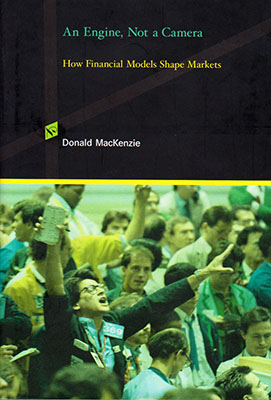 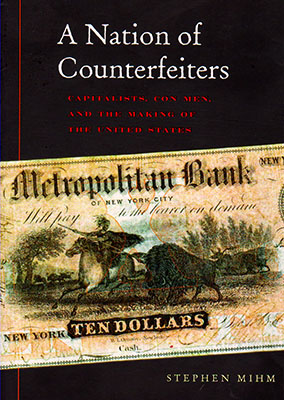
Given what we've learned about the games people, groups and nations play, what problem might reasonably we attack in class?
An International consortium has been formed to study the financial crisis: CRISIS – Complexity Research Initiative for Systemic InstabilitieS. The economic models they are using are quite complex. We might, however, begin by looking at the slip-sliding definition of the "dollar" from Colonial times to the present day: Specie (gold and silver), funding the American revolution with the Continental dollar, the paper promises of private banks,
funding the Civil War with U.S. Banknotes, from demand notes payable in silver and gold or secured by bonds to legal tender ("fiat money") and the issuance of new forms of currency in our money supply. |
| |
1 October |
3 October |
Week
5

Challenge 2
Evolutionary
Computing
|
Programming Challenge 2: Evolutionary Computation
INTRODUCTION, continued...
The visualizations and the code for a sequence optimizer:
The Travelling Salesman Problem
The Image Descrambling Problem ("a deshredder")
For THURSDAY / IMAGE DESCRAMBLER:
Why does the image descrambler "work well" (from a human perspective) on some images and not so well on others? What patterns (anomalies, glitches, curiosities) do you see in its reconstructions? Why do they occur? Are they analogous to the way evolution in the natural biological world works? What might we do to "correct them?" Create and run three (3) bitmap images through the appliction which illustrate your ideas. select images that most clearly illustrate different "success" in reconstructing the image from a human perspective. Provide screen shots and discussion of why the application "works best" on some and not on others. Include screen shots of these, before and after, and discuss them. How could you improve the application's behavior.
A note: Last Friday I gave a talk at UNC Charlotte's "Complex Systems Institute."
Too bad we don't have one here! Nevertheless, they were quite impressed by your work.
|
Programming Challenge 2: Evolutionary Computation
Continued...
To turn in:
How does the image descrambler handle different types of images?
My own quick three experiments and analyses...
What are the role of introns in biological genetics?
TOPICS:
C/C++ Classes (do-it-yourself variables and functions).
Optimizing profits from trading on the Stock Exchange.
Other sequences to optimize?
Seriation in archaeology.
Ballistics: billiards, angry birds.
Solution of a simple substitution cipher.
Creating algorithmic art.
For next week:
On SAKAI please read the articles by David Fogel and Peter Bentley on Evolutionary Computation.
(Three strong schools are Genetic Algorithms, Evolutionary Programming and Genetic Programming.)
Pick a complex problem that interests you. Describe it briefly.
How would you go about representing the problem computationally?
How would you design a fitness function to measure the "success" of a solution to that problem?
Which school of evolutionary computation would be the most appropriate representation of evolution for that problem?
How did you balance the choices (above) among the different representations of the problem and of evolution?
2-3 pages, double-spaced, hardcopy, with illustrations if they add to the discussion. |
Week
6

Challenge 2
Evolutionary
Computing
|
8 October |
10 October |
Programming Challenge 2: Evolutionary Computation: due Thursday, 10 October
The Evolutionary Concert Tour (a.k.a. Traveling Salesman Problem, Traveling Ferenghi Problem).
Continued..
Discussion of additional constraints and their implementation...
Visit nearest city next (more-or-less done).
Enhance the 3d version with new rules, stereo pairs, OpenGL.
Treat cities as islands and invoke ocean currents and trade winds.
Preference for right-angle turns, sharp turns, gradual turns.
Alter space from a bounded to a toroidal wrap-around world.
Invoke some requirement for a path leg length entering or exiting a particular city type.
Outside the realm of the Traveling Salesman Problem:
Evolve an algorithmic artwork. |
Programming Challenge 2: Evolutionary Computation: DUE TODAY
Participant Presentations
Challenge 3: Segregation/Assimilation & Growth...
Introduction...
OVER THE "HOLIDAY:"
Familiarize yourself with the Segregation/Assimilation application. Explore and experiment with the initial conditions and the rules. Examine the code to see how the application is set up. Pay special attention to the processes that "implement the rules" than those that that "do the housekeeping." Begin working on some initial conditions and rules of your own...
Note: This model is built from Thosmas Schelling's original work on segregation. The foundation of this simulation is not readily conducive to building more sophisticated agent based models such as predator/prey relationships. We may attempt to do so in the weeks ahead. In this application, as in cellular automata, agents can only be changed by their surrounds, an agent cannot directly change another agent...
|
Week
7

Challenge 3
Segregation &
Assimilation
|
15 October |
17 October
|
FALL BREAK
|
I will be at the National Cryptologic History Symposium at Johns Hopkins Appliled Physics Lab.
In my absence, please watch the film, read the three articles on SAKAI, and look at the Youtube video again.
Screening: THE THIRTEENTH FLOOR (1999) by Daniel Galouye and Josef Rusnak.
The DVD is in the drawer below the lecturn. This follows a previous book and film WORLD ON A WIRE). DVD Widescreen 100m.
DUE NEXT TUESDAY:
"THE THIRTEENTH FLOOR AND RELATED THEMES."
A) Review the scene in which the characters Douglas Hall and Jane Fuller meet for the first time.
(You may have to save this to the desktrop and run it from there.)
How well do the actors portray their characters Douglas and Jane? What is going on inside Jane's and Douglas' heads that the actors are trying to bring to the screen and how do they accomplish that? (Short, a paragraph or so.)
B) THE THIRTEENTH FLOOR and the readings on SAKAI by Greg Egan and Stanislaw Lem are fiction. The reading by me and the video are not.
There is a theme common to all five of these works. Explore those connections. Given the arguments and the evidence that they present, provide a critique of how closely the various elements in them match some of the ideas, practices and goals of computation and science in general.
Please submit this on paper, double spaced, 3+ pages as necessary. |
Week 8

Challenge 3
Segregation &
Assimilation
|
22 October |
24 October |
Challenge #3: Segregation/Assimilation.
Continued...
Possible "to-dos":
- Right-click to zoom in on a region, not just the upper left.
- Add some sort of agent memory and design some rules for it.
- Adding a "happiness" characteristic. Add it to the class declaration and modify moveMe() to move it to a new cell. Perhaps increment happiness with each moveMe() and decrement it with each !moveMe(). One might also add some rules for it. Count and display happiness by agent type at each frame, and/or replot agents showing positive or negative happiness. How would we visualize the latter? We could enlarge the display and plot happiness with the pen and agent type with the brush of a rectangle.
- Recode http://fallingsandgame.com for Embarcadero.
|
Challenge #3: Segregation/Assimilation.
Continued...
Some more thoughts on what to do:
- Import the Sluis digital elevation model. But remember the Sluis DEM is bounded and our current world is toroidal. Also, how are we going to visualize different agent types on top of a visualization of the terrain? What colors will we use?.
- Expand the agent size.
- Remember to check out the notes.
- Allow agents to climb a gradient, but only a mild slope or follow a contour.
- Drop rain or snow agents on the DEM (but we currently only allow one agent per location).
- Happiness second thoughts: If the measure is whether or not one moves, we already monitor that.
- If you add another characteristic to an agent, be sure to also add that characteristic to the moveMe() function.
|
Week
9

Challenge 3
Segregation &
Assimilation
|
!!! Saturday, 16 October / FOCUS WEEKEND (parents' day) |
29 October
|
31 October
|
Challenge #3: Segregation/Assimilation.
Continued... |
Challenge #3: Segregation/Assimilation DUE TODAY.
Challenge #4: Flocking (Herding, Schooling, Crowd Behavior).
Introduction... |
Week
10

Challenge 4
Collective Movement:
Flocking, Herding,
Schooling, Orbits
|
5 November |
7 November |
Begin thinking about your course project (due December 5th).
It can be something entirely new of your own making or it can be
a significant enhancement of a previous challenge.
Challenge #4: Flocking (Herding, Schooling, Crowd Behavior).
Continued...
A look from the outside: the user's view.
Familiarize yourselves with the variety of User's settings for both applications.
Familiarize yourselves with the rules, how they are written and how they work:
Flocking Images 26 "sweet spot" is about 4/5 of the way through the code.
Flocking Polygons 29 "sweet spot" is about 3/5 of the way through the code.
Come back on Thursday with some credible ideas for new rules...
A technical to-do list for Flocking Images:
Use smaller images / Expand the playing field / Introduce more agent sub-variables...
Improve the 3d path visualizations by implementing Red + Cyan makes White.
Connect the dots in the path array visualizations.
Expand to full Screen and auto Run (there will be a problem expanding the path arrays).
A technical to-do list for Flocking Polygons:
New functions in the agentClass: setVelocity(), getVelocity(), setDirection(), getDirection().
New sub-variables for the agentClass: acquire(), divest(), memories...
New visualization of agents: uniform triangle size regardless of velocity.
Change the orbits of Mars and Jupiter from clockwork to gravitational. |
Vi Hart
Doodling in Math Class: Dragon Scales
Folding Space-Time
Challenge #4: Flocking (Herding, Schooling, Crowd Behavior).
Continued...
A look at the inside: the code.
|
Week
11

Challenge 4
Collective Movement:
Flocking, Herding,
Schooling, Orbits
|
12 November |
14 November |
Challenge #4: Flocking (Herding, Schooling, Crowd Behavior).
Continued...
|
Challenge #4: Flocking (Herding, Schooling, Crowd Behavior).
Due Today...
Iaian Couzin: Collective Animal Behavior in Locusts and Fish...
Fish schooling in real life and in simulation...
Participant presentations...
|
Week
12

Challenge 5
Realworld DAQ:
Sensors &
Actuators
|
19 November
|
21 November |
Challenge #5: Sensors & Actuators
Introduction...
Aesthetics 102:
Beyond keyboard and display: escaping the confines of the desktop computer.
Transitioning applications into the real world:
TrackBars to IR rangefinders.
WebCams?
|
Challenge #5: Sensors & Actuators
Introduction... |
Week
13

Challenge 5
Realworld DAQ:
Sensors &
Actuators
|
26 November |
28 November |
Challenge #5: Sensors & Actuators
Continued... |
Thanksgiving Recess |
Week
14 |
3 December |
5 December
|
Course Evaluations:
Please take time to fill out these forms and add suggestions of your own at the bottom.
Challenge #5: Sensors & Actuators
Continued...
Some more cryptographic devices.
Nanocopters.
Work on Course Projects |
Course Projects due today.
Participant presentations.

|
Week
15 |
23 April |
25 April |
NO FINAL |
